A History of Coastal Ecosystem Research at NOAA
NOAA and its predecessor organizations have been conducting coastal ecosystem research since the late 19th century. Coastal ecosystem science is the study of inter-relationships among the living organisms, physical features, bio-chemical processes, natural phenomena, and human activities in coastal ecological communities. Taking an integrated approach is key to better managing and protecting our coastal resources.
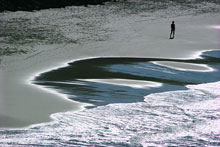
Thousands of people every year enjoy walking along the nation's beaches. NOAA's mission includes sustaining the health of these areas so future generations may also enjoy them. Click image for larger view.
Coastal and marine waters support 28.3 million jobs, generate $54 billion in goods and services, contribute over $30 billion to the economy through recreational fishing, and provide a tourism destination for more than 89 million Americans each year. Our coastal waters are among the most biologically productive regions in the nation, producing more food per acre than the best farmland. Given the importance of coastal areas, NOAA conducts coastal ecosystem research to ultimately protect, maintain, and restore these valuable ecosystems.
NOAA and its predecessor organizations have been involved in studying coastal ecosystems since the 19th century. This article traces the history of this research from its origins to its evolution and focus during the 1980s and 1990s.
The Early Years
Coastal ecological research at NOAA began in the late 19th century when the U.S. Commission of Fish and Fisheries (now NOAA's National Marine Fisheries Service) created biological laboratories at Woods Hole, Massachusetts, and Beaufort, North Carolina, in 1885 and 1890, respectively. Scientists at these laboratories conducted research to help manage commercial fishing and conducted research on the life histories of commercial fish and shellfish species. This research was in large part the vision of the Fish Commission's first director, Spencer Fullerton Baird, who recognized that good habitat and knowledge of how fishes interacted with their habitats was necessary to properly protect and enhance fisheries.
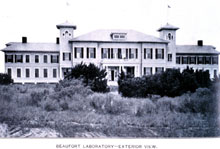
The Fish Commission's laboratory in Beaufort, North Carolina, in 1902. Click image for larger view.
Until about 1950, visiting and resident scientists at the Beaufort Laboratory contributed to and conducted research in many areas of marine science including oyster planting; the habits and development of stone crab; and other studies on scallops, oysters, and shrimp.
Coastal ecological research at NOAA that focused on human and natural stressors that affect marine resources can be traced to back 1949, when the Radiobiological Program began at the Beaufort Laboratory. Initially, the program focused on quantifying the accumulation of radioactive material (radionuclides) from nuclear weapon testing by marine organisms, whether through water, sediment, or the food web. Ironically, these studies eventually led to research in which these radionuclides were used as tools to study the pathways of chemicals through marine ecosystems. This program continued until 1981.
In 1941, the College Park Laboratory was established on the University of Maryland campus as the Bureau of Commercial Fisheries Laboratory in the U.S. Department of Interior. This laboratory was recognized for its unique technological capabilities and achievements in fisheries research, including the first nationwide survey of trace elements such as mercury and other toxic metals in fish. Pollutants, such as toxic metals, can cause a wide range of adverse biological effects in organisms, including direct chemical toxicity, genetic damage, physiological abnormalities, compromised immune systems, biochemical alterations, and behavioral aberrations.
In 1978, the College Park Laboratory became part of the Southeast Fisheries Science Center in Charleston, South Carolina. Its mission was expanded to better support the needs of fisheries managers by shifting the research emphasis to address environmental and ecological issues. Since the mid-1980s, major efforts of the lab have included chemical contaminant studies, leading to the development of improved chemical analyses and toxicity investigations; the detection of human pathogens in shellfish and their association with fecal contamination; and marine biotoxins linked with algal blooms.
Coastal Ecosystem Research at NOAA Matures
In the early 1970s, NOAA embarked on a number of efforts that were at the forefront of coastal ecosystem science. Most of the early coastal ecological research at NOAA, such as those programs described below, focused on specific contaminants and their effects.
The Marine Ecosystem Analysis Program
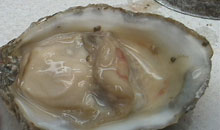
An abscess on an oyster. Click image for larger view.
The Marine Ecosystem Analysis (MESA) Program supported projects in the New York Bight (and subsequently in the Hudson-Raritan Estuary) and in Puget Sound, Washington, that assessed the effects of human activities on marine ecosystems.
The MESA Puget Sound Project spearheaded work that connected liver lesions in bottom-dwelling fish with sediment concentrations of polycyclic aromatic hydrocarbons (PAHs), which are produced by the incomplete burning of coal, oil, gas, and other organic substances. Today, NOAA scientists continue to monitor the contaminated sediments in Puget Sound and to assess the benefits of restoring these contaminated sediments.
The MESA New York Bight Project involved assessing the effects of dumping dredged material and sewage sludge in the New York Bight and understanding the effects of dumping in context with the other contamination flowing into the Bight from widespread pollution sources. Subsequently, the MESA Hudson-Raritan Estuary Project examined the effects of human activities on the estuary and its living marine resources and on the transport of contaminants from the estuary into the New York Bight.
The last of the MESA projects ended in the late 1980s.
The Outer Continental Shelf Environmental Assessment Program
The Outer Continental Shelf Environmental Assessment Program (OCSEAP) was created to conduct assessment of the biological resources associated with the outer continental shelf which were required to ensure the environmentally safe extraction of oil from the North Slope of Alaska. OCSEAP ended in the late 1980s. NOAA's Office of Response and Restoration Emergency Response Division, which responds to spills of oil and other hazardous materials, continues to apply expertise such as knowledge of what lives where, biological resources, etc., gained by this early program.
The National Status & Trends Program
The National Status & Trends (NS&T) Program began in 1984. Its mission was (and still is) to obtain a national sense of the distribution and effects of chemical contamination in the coastal United States in order to evaluate the health of the nation's coastal waters and improve overall environmental quality.
One project, the NS&T Benthic Surveillance Project, monitored liver lesions in bottom fish throughout the U.S. from 1984 to 1992. In general, these studies showed that the effects of contamination were limited to industrialized areas.
The NS&T Mussel Watch Project, begun in 1986, remains active, and uses mussels and oysters from more than 250 coastal and Great Lake sites to monitor levels of chemical contamination. In general, contamination levels have been found to be higher in urban areas than elsewhere, with definite, downward trends over time for chemicals whose use has been banned or severely restricted.
Addressing Coastal Issues
During the late 1980s and 1990s, NOAA began expanding research efforts to assess broader coastal issues such as hypoxia and harmful algal blooms.
The Dead Zone
Coastal hypoxia (i.e., low levels of dissolved oxygen in water) has increasingly been recognized as an ecological problem. Hypoxia is often attributed to excess additions of nitrogen and phosphorus into the water, which subsequently stimulate algal growth (eutrophication) and result in loss of oxygen as the algae decay. Sorting out the causes of coastal eutrophication has been a major emphasis of NOAA’s Coastal Ocean Program (COP) since its inception in 1990.
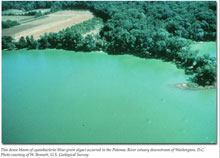
This dense bloom of cyanobacteria (blue green algae) occurred in the Potomac River, downstream of Washington, DC. Click image for larger view.
A major achievement of the COP was reconstructing the history of the large, recurring hypoxic zone, often called the “dead zone,” in the northern Gulf of Mexico. Scientists quantified the mostly human-related sources of nitrogen that come down the Mississippi River and are deposited in the Gulf of Mexico, which leads to the hypoxia.
Each year, scientists use the results of their research to make a prediction about the extent of the hypoxic zone. Hypoxia can cause fish to leave the area and can cause stress or death to bottom-dwelling organisms that are unable move out of the hypoxic zone. Hypoxia forecasts are used by coastal resource managers to assess alternative management strategies for preventing or mitigating the impacts of hypoxia on coastal ecosystems and to make informed decisions regarding this important environmental phenomenon.
Harmful Algal Blooms
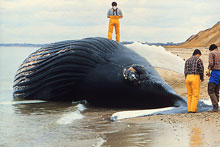
Over 50 percent of unusual marine mammal mortality events are caused by harmful algal blooms. Click image for larger view.
Since the late 1980s, the frequency of harmful algal blooms (HABs) along all continental U.S. coasts has increased. HABs are blooms of algae that are toxic to fish, marine mammals, and humans. NOAA is studying the ecology of HABs in order to understand the natural and human-related factors that control growth of the algae. NOAA is also devising ways to detect HABs by chemical and physical means and by using satellite imagery. On the Florida coast, the satellite imagery has provided advanced detection of blooms, allowing state and local officials to better direct resources for sampling.
New Directions in Coastal Ecosystem Research
In recent years, NOAA has moved in several new directions with its coastal ecosystem research, including studying environmental impacts on coral reefs and estuaries and the impacts of the environment on human health. These new activities, when combined with existing programs, help NOAA to provide targeted information needed to manage and protect a healthy coastal environment.
Today, NOAA has many facilities throughout the country that are dedicated to protecting the nation’s coastal, oceanic, and Great Lakes ecosystems. Research is an integral part of maintaining and protecting these resources.
